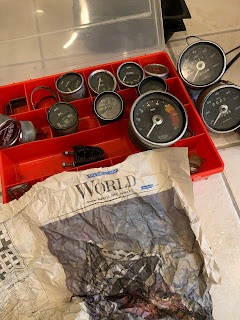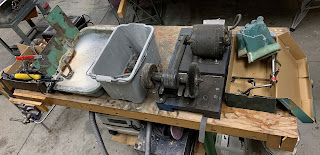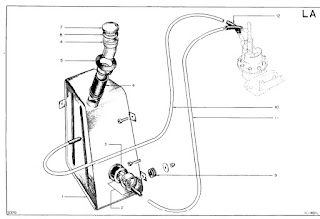Fascia and its Components
Plenty of detail work to do here. See the photo below, the collection of smiths and other gauges that I had collected. The date on the newspaper tells the story of the restoration - the car was disassembled in 2002.
A reference for smiths gauge restoration. Nice job!
http://www.74tr6.com/gauges.htm
Emily's fascia board was intact though cracked. Fortunately was a perfect template for a replacement, made by my father to his typical exacting standards. He also made a fiberglass replacement for the glove bin. Note that the holes for switches were not cut, to leave the option of using a different type of switch.
I have two original instrument nacelles, both cracked. This part begs for a fiberglass replacement, yet another fussy project.. Note that one is substantially thicker than the other. Simplicate and reduce cheapness?
The vent openings are in good shape, though the chrome is worn off the plastic. I will probably remove what's left, leaving them black.
Instruments of confusion
A fine collection of instruments, but from three manufacturers, I'm pretty sure the SW instruments came installed in the car (part of the TC install) and the others may have come from a parts lot I picked up along the way.
The scale on the middle fuel gauge looks older than the other two.
The middle is likely original, The black one and the SW use a pressure tube, the middle one is electric.
Lucas!
Both speedometers read in the low 30,000 mile range. Apparently the life span of a Europa that died a natural death. They are the same diameter, the photo's perspective distorts the size.
Disappointingly, only one tach.
It is probably worth understanding the compatibility of the 4AGE and NG transaxle before investing time and effort in these gauges.
Switches and other hardware
Below are the windshield washer pump/wiper switch, the heat and light switches, the ignition key, and some other pull switch added by a PO. (it is far too rugged to be original) The threads on the pump switch are stripped - too bad, the pump still pressurizes and the ostomy bag/manual washer pump setup is kind of quaint..
I believe the switches can be restored, and the key does work, with a firm positive action.
Lights and Heat
The switches still operate positively, and the terminals were intact. The plastic rockers seem solid but appear to be covered with some sort of grey film or oxide. A wash with alcohol and 20 minutes wet sanding produced the result below - a very clean smooth finish, complete with the same grey film or oxide. I then blasted the innards with contact cleaner, and the switches ceased to operate smoothly. So it goes. I guess they need to be lubricated. I'll get some plastic paint to restore the toggles. I believe I have a few spares.
Wiper/Washer
The Europa came stock with a plastic IV or ostomy bag in the frontfront trunk for windscreen fluid, delivered by a manual pump operated from the fascia. When I was a yoot, these funky things were a source of embarrassment for MG owners, and were often replaced with electric pumps. I'll try to salvage one of the two manual pumps I have, most likely the one on the right as the plastic threads on the other (original type) are damaged. Or.... I'll just cop out and install an electric pump.
Rocker switches in total
Hazard - SPST
Heat and light switches
Heat - interesting circuit. Up=off. Middle - fresh air blower.. Down, fresh air blower AND rad fan. Down position to be used "in heavy traffic" per the manual. Despite its name, this switch does not control the heat, only the fan(s).
The switch has three terminals. In the up position, with the rocker depressed to the same side as the terminals, all circuits are open.
Off (up)
One Circuit Closed (middle)
Both Circuits Closed (down)
With the rocker in the middle, the centre terminal and the "throw" terminal on the same side are connected.
In the down position, with the rocker depressed to the side opposite the terminals, all three are terminals are connected. The centre terminal is the "pole" and the other two are "throws", progressively connected with each rocker position. Quite unusual, and more like a rotary switch might be used.
Why on earth (Why in Britain?) would one need to engage the rad fan in concert with the cabin ventilation fan, (but not separately) heat or otherwise?
The light switch works similarly, with the up position being off, the middle position energizing the instrument and indicator lights only, (running lights) and the down position also powering those light circuits which are further controlled at the steering column. (turn signals, headlights.) This could be overcome by electing to operate with full time running lights.
The heat is controlled by a pull-cable on the chassis top, alongside the choke. With teh 4AGE, this cable may not be required as a solenoid operated heater plumbing may exist.


















Comments
Post a Comment